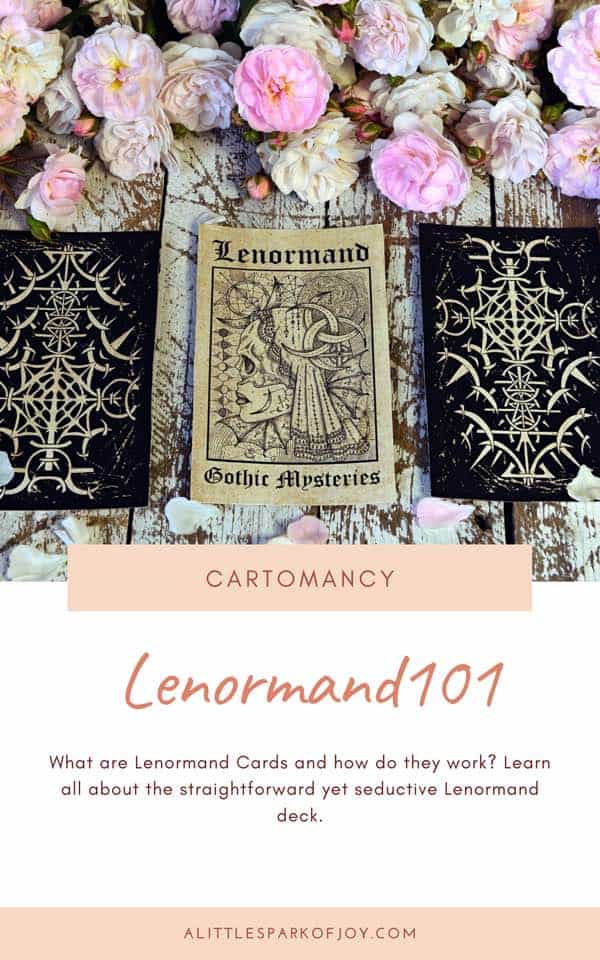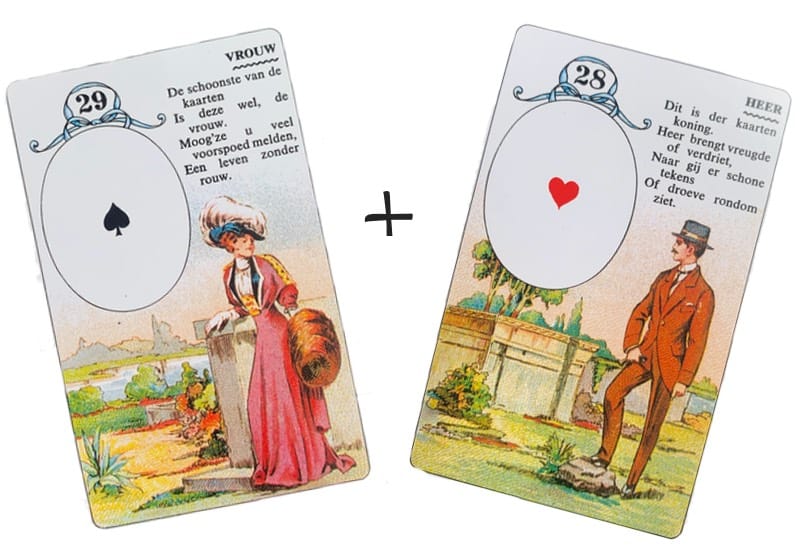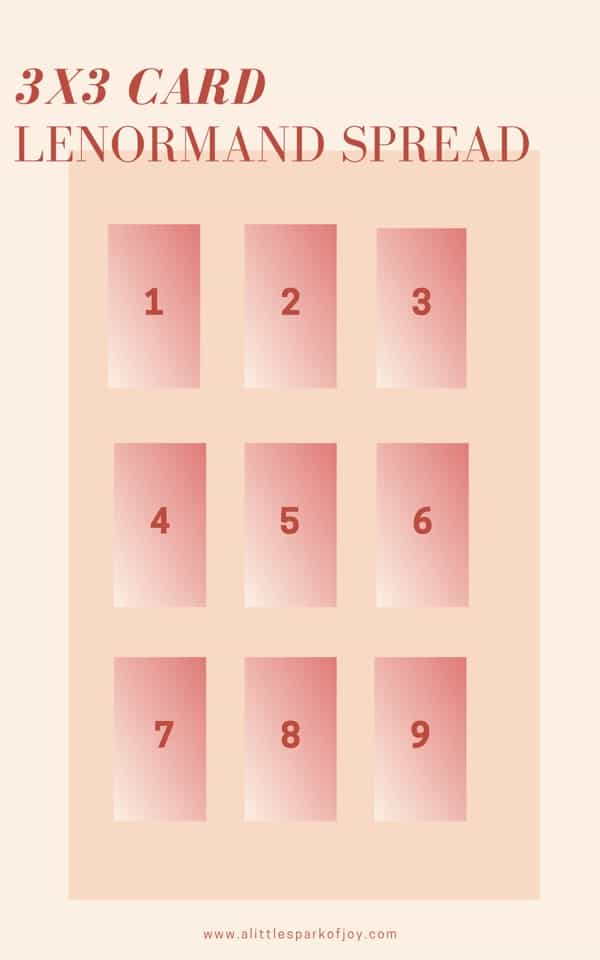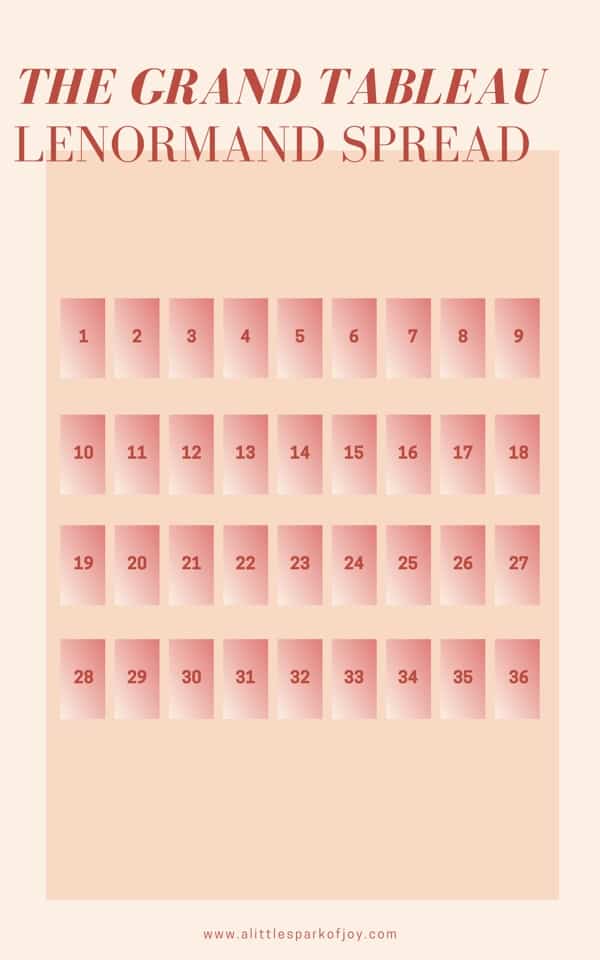Have you ever wanted to try reading other cards than tarot cards? Or are you not drawn to tarot cards at all, but still want to practice fortune-telling? If so, I’ve got good news for you! Apart from tarot and oracle cards, you can also read the Lenormand cards.
Many readers are more familiar with tarot cards than with Lenormand cards. The two types of card reading do have many similarities: the practice of asking a question before drawing cards, interpreting symbols on cards, and finding patterns in spreads to gain insight into your life.
However, Lenormand cards and tarot cards have different symbols and invite different approaches to divination. In this article, I will teach you how to read the straightforward yet seductive Lenormand cards.

Table of Contents
Lenormand Cards History
First, let’s talk a bit about the history of the Lenormand deck. The Lenormand cards bear the name of Marie Anne Lenormand, a French fortune-teller who supposedly advised leaders of the French Revolution. After her death, game-makers released the Grand Jeu (“Big Game”) and Petit Jeu (“Little Game”), both inspired by her divination practices.

The Grand Jeu requires a full deck of playing cards, but the Petit Jeu uses just 36 cards. The Petit Jeu, based on a game of chance designed by a German businessman, borrowed Lenormand’s name and gained popularity in the 1800s.
When people say “Lenormand cards,” they are most likely referring to the Petit Jeu, which I discuss below.
Lenormand Cards Meanings
Each of the 36 cards in the Lenormand deck features a well-defined symbol. Just like tarot cards, Lenormand cards are interpreted in combinations. As you will learn, each card often represents a noun (person, place, or thing) or an adjective (a description or modifier).
The chart below gives key nouns and adjectives for each card. You’ll notice some overlap with the Major Arcana of the tarot deck! For example, the Star, the Moon, and the Sun all appear in the Lenormand deck and carry the same basic meaning.
And even though most symbols differ, you will also find some similarities with the Major Arcana in the progression of card meanings.
| Card | Keywords (Nouns) | Keywords (Adjectives) |
| 1. Rider | News, Message | Fast, Passionate, Athletic |
| 2. Clover | Opportunity, Luck | Hopeful, Optimistic, Excited |
| 3. Ship | Travel, Farewell | Adventurous, Seeking, Risk-taking |
| 4. House | Home, Tradition | Safe, Stable, Comfortable |
| 5. Tree | Growth, Past Connection | Healthy, Grounded, Spiritual |
| 6. Clouds | Misunderstanding, Secrets | Confused, Doubtful, Insecure |
| 7. Snake | Desire, Deception | Sexual, Seductive, Betrayed |
| 8. Coffin | Grief, Ending | Mournful, Depressed, Transformative |
| 9. Bouquet | Social Life, Gift | Beautiful, Charming, Inviting |
| 10. Scythe | Warning, Accident | Sudden, Dangerous, Definitive |
| 11. Whip | Conflict, Discipline | Scolding, Argumentative, Angry |
| 12. Birds | Communication, Relationship | Restless, Anxious, Gossipy |
| 13. Child | New Beginning, Children | Innocent, Naive, Playful |
| 14. Fox | Job, Self-Care, Lies | Clever, Cunning, Deceitful |
| 15. Bear | Boss, Leader | Strong, Dominant, Influential |
| 16. Stars | Dreams, Progress | Hopeful, Inspiring, Optimistic |
| 17. Stork | Transition, Relocation | Graceful, Dynamic, New |
| 18. Dog | Friend, Pet | Devoted, Loyal, Supportive |
| 19. Tower | Government, Ego | Arrogant, Lonely, Established |
| 20. Garden | Community, Event | Popular, Performative, Cultured |
| 21. Mountain | Obstacle, Delay | Stuck, Stubborn, Challenging |
| 22. Crossroads | Choice, Trip | Hesitant, Independent, Indecisive |
| 23. Mice | Loss, Disease | Stressed, Costly, Damaged |
| 24. Heart | Love, Romance | Forgiving, Caring, Gentle |
| 25. Ring | Contracts, Marriage | Committed, Stable, Promising |
| 26. Book | Education, Research | Informed, Knowledgeable, Secret |
| 27. Letter | Conversation, Document | Communicative, Expressive |
| 28. Man | Man in the Querent’s Life | Masculine |
| 29. Woman | Woman in the Querent’s Life | Feminine |
| 30. Lily | Retirement, Peace | Wise, Older, Sensual |
| 31. Sun | Success, Recognition | Happy, Fortunate, Warm |
| 32. Moon | Subconscious, Imagination | Artistic, Emotional, Attractive |
| 33. Key | Resolution, Spiritual Connection | Open, Liberated, Destined |
| 34. Fish | Wealth, Business, Water | Abundant, Luxurious |
| 35. Anchor | Foundations, Achievement | Faithful, Resilient, Secure |
| 36. Cross | Principles, Religion | Dutiful, Suffering, Burdened |
Patterns of Lenormand Cards
Tarot card readings tend to draw out a querent’s inner feelings and motivations in order to predict events, but Lenormand cards more often represent concrete or external things.
Looking down at a Lenormand cards spread is a little like looking down at a map of someone’s life in one specific moment.
Where is that person located? Who is around him or her? What or who affects the current situation?
Remember that there are infinite card combinations and therefore infinite interpretations! As you gain experience as a card reader, your interpretations may also differ from the basic ones offered in the chart above.
As you’re learning, you can refer to the chart as you look for the basic patterns listed below.
The Significator
The significator is the card that represents a querent (or you, if you’re reading yourself). A significator is especially important in the Grand Tableau spread, which uses all 36 cards in the deck, described in more depth below.
Finding the significator is like finding the spot on a map you’d like to study, and the arrangement of cards around the significator will tell you important information about a querent’s life.

The most basic significators are the Man and the Woman. If you identify as a woman, the Woman represents you. If you identify as a man, the Man represents you. If you want to gain insight into a particular part of your life, you can choose a different significator.
For instance, you might choose the Crossroads if you are on the verge of a big decision.
Some readers like to choose an appropriate significator for themselves or their querents before completing readings. More commonly, readers find the significators in the cards they draw, whether they draw three cards or 36 cards.
Pairs
To interpret a pair of Lenormand cards, many readers call the first card a person, place, or thing, and the second card becomes a word or phrase that modifies this noun. You can use the chart in “Lenormand Card Meanings” to find appropriate nouns and adjectives.

As an example, let’s say you draw the Sun, and then you draw the Letter. This pair could be interpreted as a widely communicated or broadcasted success because the Sun provides the noun (success), and the Letter gives us the adjective (communicated).
If the cards were flipped (Letter + Sun), the interpretation differs slightly. The Letter becomes the noun, which could be a conversation or document.
The Sun represents a successful or happy thing. Therefore, the Letter + Sun might mean a successful conversation or even a new publication!
Mirroring
Mirroring is a more advanced technique for pairing cards that are not next to each other in a spread.
To mirror, imagine that you draw vertical and horizontal lines that divide the spread precisely in half. Then, imagine folding the spread along each line. Whichever cards would be positioned on top of one another are mirrored.
In a 3-card spread, the horizontal axis won’t matter because the spread only has one row of cards. However, the first and third cards in the spread are mirrored along the vertical axis.

In a Grand Tableau that contains four rows of nine cards, you will want to find the two cards that mirror the significator.
Mirroring gives you more information about what affects the significator or influences the focus card.
Let’s say you’re curious about your love life, so you pick the Heart as your significator in a Grand Tableau. Along the vertical axis, the Heart is mirrored by the Rider, which tells you that a new love interest will enter your life soon.
Along the horizontal axis, the Heart is mirrored by the Garden, which provides the additional information that you might meet this love interest at an upcoming gathering or within your community.
Knighting
A card “knights” a significator when it creates an L-shape with the significator, the way a knight moves in a game of chess. Knighting is one of the most advanced reading techniques, and it’s typically used to reveal hidden influences.
The number of cards that knight the significator will depend on the placement of the significator in the spread.
In our example above, the Heart mirrored the Rider and the Garden, representing a new love interest at a community gathering.
If the Heart were also knighted by the Snake and the Mountain, we have new information: obstacles and deception. In this case, the love interest could be hiding something, like his or her involvement in another relationship.
Lenormand Spreads
Now that you know some of the patterns to look for, you can apply your knowledge to a spread.
You can get creative with your spreads, and you may already feel comfortable branching out in tarot readings.
The three spreads below, however, are common foundations, and you can build on each one to progress to the next.
3-Card Lenormand Spread
This spread is a classic for any cartomancer.

Follow these basic steps to perform a 3-card reading for yourself:
- Shuffle the deck while thinking of a question, conflict, or focus area.
- Draw three cards, placed in a row from left to right.
- Turn over the second card, which represents the focus or theme of the spread. If you want, you can think of this card as the significator.
- Read the first and second cards as a pair. Then, read the second and third cards as a pair. These give you insights into what directly influences you or your problem. By sequencing these interpretations, you can create a story.
- Finally, to determine the next steps or predict events, mirror the first and third cards. This step tells you how the people, places, and things in your life might be influencing each other. Considering how the two things interact could help you make important decisions.
3×3 Lenormand Spread
This spread involves three rows of three cards, which makes knighting possible for most card positions.

This spread isn’t the best for fast answers, but it provides more depth than a 3- or 5-card spread. Try these steps:
- Shuffle the deck while thinking of a question, conflict, or focus area.
- Draw nine cards, laying them out in three rows from left to right and top to bottom.
- Read the center card (or fifth card) as the significator.
- The first column represents the past, and the third column is the future. Therefore, pair the center card with the fourth card to learn about recent past events. Pair with the sixth to learn about what’s coming.
- The top row represents people, places, and things you’re aware and can currently influence, and the bottom represents things in your subconscious that have yet to come to light. Pair the center card with the second card to learn about your highest potential. Pair with the eighth card to learn about what’s motivating you that you might not fully understand.
- Mirror the fourth and the sixth cards to learn how your past is influencing your future. Mirror the second and eight cards to see how your subconscious may help or hinder your greatest potential.
- Notice the general tone by counting how many positive and negative cards are present in the spread. If any card stands out to you or confuses you, knight it with another card or cards to learn more about hidden influences.
The Grand Tableau Lenormand Spread
Grand Tableau is French for “big picture,” and this spread is indeed large. It won’t be quick, but by using all 36 cards, it will provide the most detail.

The Grand Tableau offers many interpretative possibilities, but these steps outline the basics:
- Shuffle the deck while thinking of a question, conflict, or focus area.
- Lay out all 36 cards in four rows of nine cards, moving from left to right and top to bottom.
- Find the significator. This could be either the Man or Woman, depending on how you identify, or you could pick another card that represents your current concern. It’s helpful to choose your significator before you draw cards so that you aren’t influenced by the pattern you see!
- Pair with the cards the the left, right, above, and below the significator just as you would in a 3×3 spread.
- Mirror the significator to find the two cards that represent direct influences on the situation.
- Knight the significator to discover the hidden influences.
- Determine the “house” of the significator. To do this, imagine all 36 cards arranged in the Grand Tableau in order. Which card in the original order does the significator correspond with? This corresponding card is the significator’s house. For example, let’s say the Heart (your significator) is in the sixteenth position. The sixteenth card is the Stars, which tells you that your love life is aligned with your dreams, and you are feeling hopeful or optimistic about coming closer to what you want.
Living the Lenormand Life
There’s so much more to learn about Lenormand, but I hope you now have some excellent ideas about where to start! What questions do you still have? What are you most excited to try? What tips or tricks have you learned?
Ktir says
I just need help understanding these layout. I’m on the dense line about a relationship. But the man is a celebraty but I’ve been talking to him for a little while and he asked me to do something I need to know what to do it’s a fish heart and letter
Wille says
Hey, don’t do anything you don’t want to do!
Wille xxxx